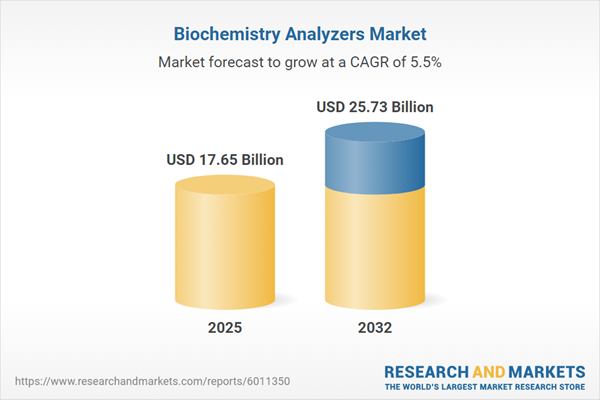Speak directly to the analyst to clarify any post sales queries you may have.
The biochemistry analyzers market is evolving rapidly as healthcare organizations and research institutions worldwide seek streamlined diagnostic solutions and data-driven precision for clinical and research environments.
Market Snapshot: Biochemistry Analyzers Market
The biochemistry analyzers market grew from USD 16.74 billion in 2024 to USD 17.65 billion in 2025, with projections indicating ongoing expansion at a CAGR of 5.51% and a value of USD 25.73 billion by 2032. This upward trend is driven by growing demand for high-throughput and portable clinical testing, growing adoption in decentralized healthcare settings, and the integration of advanced digital technologies across laboratories and research centers. Senior decision-makers are increasingly focused on future-ready platforms that deliver rapid, reliable diagnostics and operational efficiency while maintaining compliance and cost-effectiveness.
Scope & Segmentation
- Product Types: Benchtop analyzers, floorstanding analyzers, portable analyzers
- Components: Analyzers, reagents & consumables, software
- Operational Modes: Fully automated, manual, semi-automated
- Technologies: Chromatography, electrophoresis, immunoassay analyzers, spectrophotometry
- Sample Types: Blood, saliva, tissue samples, urine
- End-Users: Academic institutions, specialty schools, universities, biotechnology & pharmaceutical companies, diagnostic laboratories, hospitals
- Regions: Americas (including United States, Canada, Mexico, Brazil, Argentina, Chile, Colombia, Peru), Europe, Middle East & Africa (including United Kingdom, Germany, France, Russia, Italy, Spain, Netherlands, Sweden, Poland, Switzerland, United Arab Emirates, Saudi Arabia, Qatar, Turkey, Israel, South Africa, Nigeria, Egypt, Kenya), Asia-Pacific (including China, India, Japan, Australia, South Korea, Indonesia, Thailand, Malaysia, Singapore, Taiwan)
- Key Companies: Abbott Laboratories, Beckman Coulter by Danaher, Thermo Fisher Scientific, Siemens Healthineers, Roche, Sysmex, Mindray, and others specializing in instrumentation, reagents, and software development for biochemistry analysis
Key Takeaways for Senior Decision-Makers
- Demand is rising for integrated nodes that connect biochemistry analyzers to digital laboratory ecosystems, supporting rapid decision-making, remote monitoring, and streamlined data management.
- Miniaturization and automation are enabling broader use of analyzers in both centralized labs and mobile or resource-limited settings, supporting decentralized and point-of-care diagnostics.
- Evolving regulatory requirements such as ISO 15189 and CLIA are shaping the features and compliance workflows of both hardware and supporting software, emphasizing robust quality assurance and audit traceability.
- Modular and scalable designs enable flexible deployment, supporting fluctuating sample volumes and specialized test development across diverse end-user groups.
- Trends show growing investment in proprietary reagent formulations and software-driven quality control, aiming to ensure reliable performance, compliance, and simplified workflow integration.
- Collaborative partnerships among instrumentation, reagent, and software companies are accelerating integrated solution delivery, enhancing competitive positioning in diverse global regions.
Tariff Impact on Supply Chains and Pricing Structure
Recent introduction of cumulative tariffs in the United States has compelled manufacturers and their partners to adjust sourcing and production strategies for biochemistry analyzers and related reagents. Original equipment manufacturers and suppliers are diversifying supply chains, exploring domestic and nearshore production, and seeking preferential pricing to cushion the impact of higher import duties. Downstream, laboratories and health institutions are reassessing equipment investment and maintenance plans, emphasizing more rigorous cost-benefit analyses and long-term agreements to manage budget pressures. These supply chain measures are key for sustaining growth and operational continuity amid volatile trade environments.
Research Methodology & Data Sources
The analysis in this report is grounded in a hybrid methodology combining structured interviews with laboratory professionals and procurement leaders across end-user segments, and extensive secondary research of peer-reviewed publications, regulatory filings, and technical documents from leading market participants. Quantitative modeling, scenario analysis, and cross-source validation ensure robust and reliable market insights.
Why This Report Matters
- Enables evidence-based investment and procurement decisions by providing comprehensive segmentation and actionable forecasts tailored to regional market realities.
- Informs strategic planning by highlighting the implications of technology advances, regulatory compliance requirements, and supply chain shifts on market access and competitive advantage.
- Supports risk mitigation by elucidating the impact of tariff adjustments and evolving regulatory frameworks on both upstream suppliers and downstream end-users.
Conclusion
Biochemistry analyzers remain central to evolving clinical diagnostics and research applications, with innovation, integration, and adaptability as critical drivers. Access to comprehensive insights will empower leaders to respond strategically and capture opportunities in a dynamic market landscape.
Additional Product Information:
- Purchase of this report includes 1 year online access with quarterly updates.
- This report can be updated on request. Please contact our Customer Experience team using the Ask a Question widget on our website.
Table of Contents
3. Executive Summary
4. Market Overview
7. Cumulative Impact of Artificial Intelligence 2025
Companies Mentioned
The companies profiled in this Biochemistry Analyzers market report include:- Abbott Laboratories
- Awareness Technology, Inc.
- Beckman Coulter Inc. by Danaher Corporation
- Bio-Rad Laboratories, Inc
- bioMérieux PLC
- BioSystems, S.A.
- Chengdu Seamaty Technology Co., Ltd.
- DiaSys Diagnostic Systems GmbH
- DIESSE Diagnostica Senese S.p.A.
- ELITechGroup SAS by Bruker Corporation
- F. Hoffmann-La Roche Ltd.
- Fujifilm Holdings Corporation
- Hitachi Ltd.
- Hologic, Inc.
- HORIBA, Ltd.
- JEOL Ltd.
- Meril Life Sciences Pvt. Ltd.
- Oscar Medicare Pvt. Ltd.
- PSJ Biochem Diagnostic Private Limited
- QuidelOrtho Corporation
- Randox Laboratories Ltd.
- Recorders & Medicare Systems P Ltd.
- Shenzhen Mindray Bio-Medical Electronics Co., Ltd.
- Shenzhen New Industry Biomedical Engineering Co., Ltd.
- Siemens Healthineers AG
- Sysmex Corporation
- Thermo Fisher Scientific Inc.
- Transasia Bio-Medicals Ltd.
- Trivitron Healthcare
Table Information
| Report Attribute | Details |
|---|---|
| No. of Pages | 198 |
| Published | November 2025 |
| Forecast Period | 2025 - 2032 |
| Estimated Market Value ( USD | $ 17.65 Billion |
| Forecasted Market Value ( USD | $ 25.73 Billion |
| Compound Annual Growth Rate | 5.5% |
| Regions Covered | Global |
| No. of Companies Mentioned | 30 |









